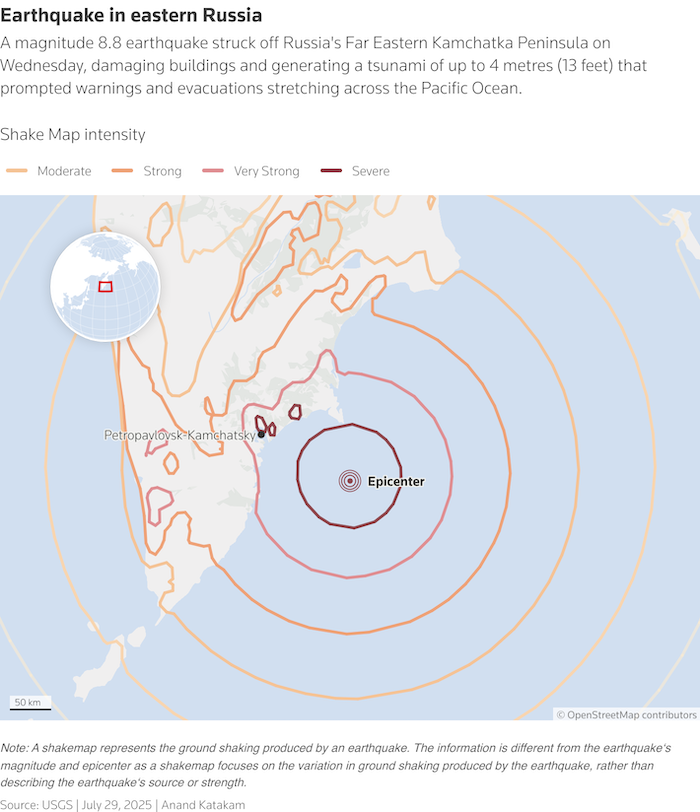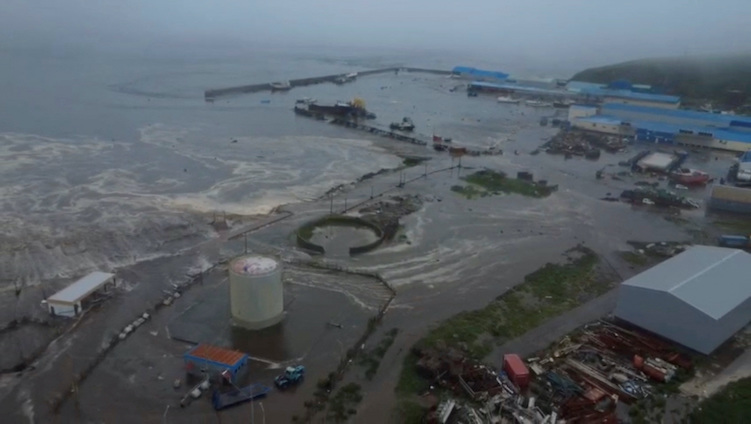One of the most powerful earthquakes in decades rocked Russia’s Far Eastern Kamchatka Peninsula – and triggered tsunami warnings right across the Pacific Ocean on Wednesday.
The 8.8 magnitude quake sparked warnings of possible tsunami waves of up to 5 metres (16 feet) and evacuation orders in parts of Japan, Hawaii and islands across the Pacific.
The shallow earthquake damaged buildings and injured several people in the remote Russian region, while much of Japan’s eastern seaboard – devastated by a 9.0 magnitude earthquake and tsunami in 2011 – was ordered to evacuate.
ALSO SEE: Thailand, Cambodia Agree to Ceasefire After 5 Days of Clashes
Toyota suspends production
In Japan, Toyota – the world’s biggest carmaker – suspended operations at eight plants, located mainly on the Pacific coast in the Tohoku and Chubu regions, due to tsunami warnings after the quake, according to a report by Nikkei.
Operations at 14 production lines were curtailed and a decision on whether to restart tomorrow would be made later this evening, it said.
Nikkei said the quake warning created a “sense of urgency among residents” in more than 200 municipalities across the country, which issued evacuation orders.
Local officials who experienced the ‘Great East Japan Earthquake’ in 2011 “used drones to urge people to flee to higher ground,” it said.
Waves flood Severo-Kurilsk port
A resident in the city of Petropavlovsk-Kamchatsky said the shaking rumbled for several minutes.
“I decided to leave the building,” said Yaroslav, 25. “It felt like the walls could collapse any moment. The shaking lasted continuously for at least 3 minutes.”
Tsunami waves struck parts of Kamchatka, partially flooding the port and a fish processing plant in the town of Severo-Kurilsk and sweeping vessels from their moorings, regional officials and Russia’s emergency ministry said.
“Today’s earthquake was serious and the strongest in decades of tremors,” Kamchatka Governor Vladimir Solodov said in a video posted on the Telegram messaging app. Russian scientists said it was the most powerful quake to hit the region since 1952.

In Hawaii, coastal residents were told to get to high ground or the fourth floor or above of buildings, and the US Coast Guard ordered ships out of harbours as the tsunami approached.
“Take Action! Destructive tsunami waves expected,” the Honolulu Department of Emergency Management said on X.
Shortly after 0730 GMT, the Pacific Tsunami Warning Center said waves of up to 1.7 metres (5.5 feet) were impacting the Hawaiian islands. State Governor Josh Green had earlier said no waves of consequence had hit Hawaii, but all flights in and out of Maui had been cancelled.
Fukushima nuclear plant evacuated
The US Geological Survey said the earthquake was shallow at a depth of 19.3 km (12 miles), and centred 119 km (74 miles) east-southeast of Petropavlovsk-Kamchatsky, a city of 165,000.
It revised the magnitude up from 8.0 earlier, and reported a series of strong aftershocks up to a magnitude of 6.9.
Tsunami alarms sounded in coastal towns across Japan’s Pacific coast and evacuation orders were issued for tens of thousands of people.
Workers evacuated the stricken Fukushima nuclear plant, where a meltdown following the 2011 tsunami caused a radioactive disaster, operator TEPCO said.
Footage on public broadcaster NHK showed scores of people on the northern island of Hokkaido on the roof of a building, sheltering under tents from the beating sun, as fishing boats left harbours to avoid potential damage from the incoming waves.
Broadcaster Asahi TV reported a 58-year-old woman died when her car fell off a cliff while she was evacuating in central Japan’s Mie prefecture.
Automaker Nissan Motor suspended operations at certain domestic factories in Japan to ensure employee safety, Kyodo news agency reported.
Three tsunami waves had been recorded in Japan, the largest of 1.3 metres (4.3 feet), officials said.
Japan’s Chief Cabinet Secretary Yoshimasa Hayashi said there were no injuries or damage reported so far, and no irregularities at any nuclear plants.
Tsunami waves of between 1-3 metres (3-9 feet) can be fatal for people who are swept away, said NHK. They can also cause flooding and damage wooden buildings, with people at risk of being killed by large drifting objects, according to the Japan Lifesaving Association.
The US Tsunami Warning System also warned of “hazardous tsunami waves” spreading across the Pacific.
Waves reaching more than 3 metres were possible along some coasts of Russia, the northern Hawaiian islands and Ecuador, while waves of 1-3 metres were possible in countries including Japan, Hawaii, Chile and the Solomon Islands, it said.
“Due to a massive earthquake that occurred in the Pacific Ocean, a Tsunami Warning is in effect for those living in Hawaii,” US President Donald Trump said in a social media post.
Tsunamis of 3-5 metres hit Russia
Russia’s Ministry for Emergency Services said on Telegram that a kindergarten was damaged but most buildings withstood the quake. No serious injuries or fatalities have been reported.
Several people in Kamchatka sought medical assistance following the quake, Oleg Melnikov, regional health minister, told Russia’s TASS news agency.
In Severo-Kurilsk in the northern Kuril islands, south of Kamchatka, tsunami waves exceeded 3 metres, with the largest up to 5 metres, Russia’s RIA news agency reported.
Alexander Ovsyannikov, the town’s mayor, said four tsunami waves had passed.
He urged residents to assess damage to their homes and not to use gas stove heating until inspections had been carried out, in order to avoid a risk of carbon monoxide poisoning.
Power to the Sakhalin region had been cut off due to damage to the electricity grid, RIA said, citing the regional governor.
Kamchatka and Russia’s Far East sit on the Pacific Ring of Fire, a geologically active region that is prone to earthquakes and volcanic eruptions.
“However, due to certain characteristics of the epicentre, the shaking intensity was not as high … as one might expect from such a magnitude,” said Danila Chebrov, director of the Kamchatka Branch of the Geophysical Service, on Telegram.
“Aftershocks are currently ongoing … Their intensity will remain fairly high. However, stronger tremors are not expected in the near future. The situation is under control.”
Reuters with additional editing by Jim Pollard
NOTE: Further text was added to this report (about Toyota and Japan) on July 30, 2025.
ALSO SEE:
At Least 30 Dead After Huge Downpour in Beijing’s ‘Rain Trap’
Australian Court Ends Coal Mine Approval After ICJ Climate Ruling
UN Court Lays Ground For Action Against Countries’ Climate Inaction
Climate Chaos ‘Could Disrupt Half of Global Chipmaking by 2050’
China’s Losses From Floods, Disasters in First Half: $7.6 Billion
Bridge to Nepal Washed Away as Flash Floods Rock China
Floods Swamp Cities in Southwest China, And More Storms Due
Firms Underestimating Risks From Carbon-Fuelled Climate Change
Continued Fossil Fuel Investments Put $557 Trillion ‘At Risk’
Continuing Rise of Methane Emissions Worrying Top Scientists
Japan to Restart Nuclear Reactors to Avoid Russian Gas

